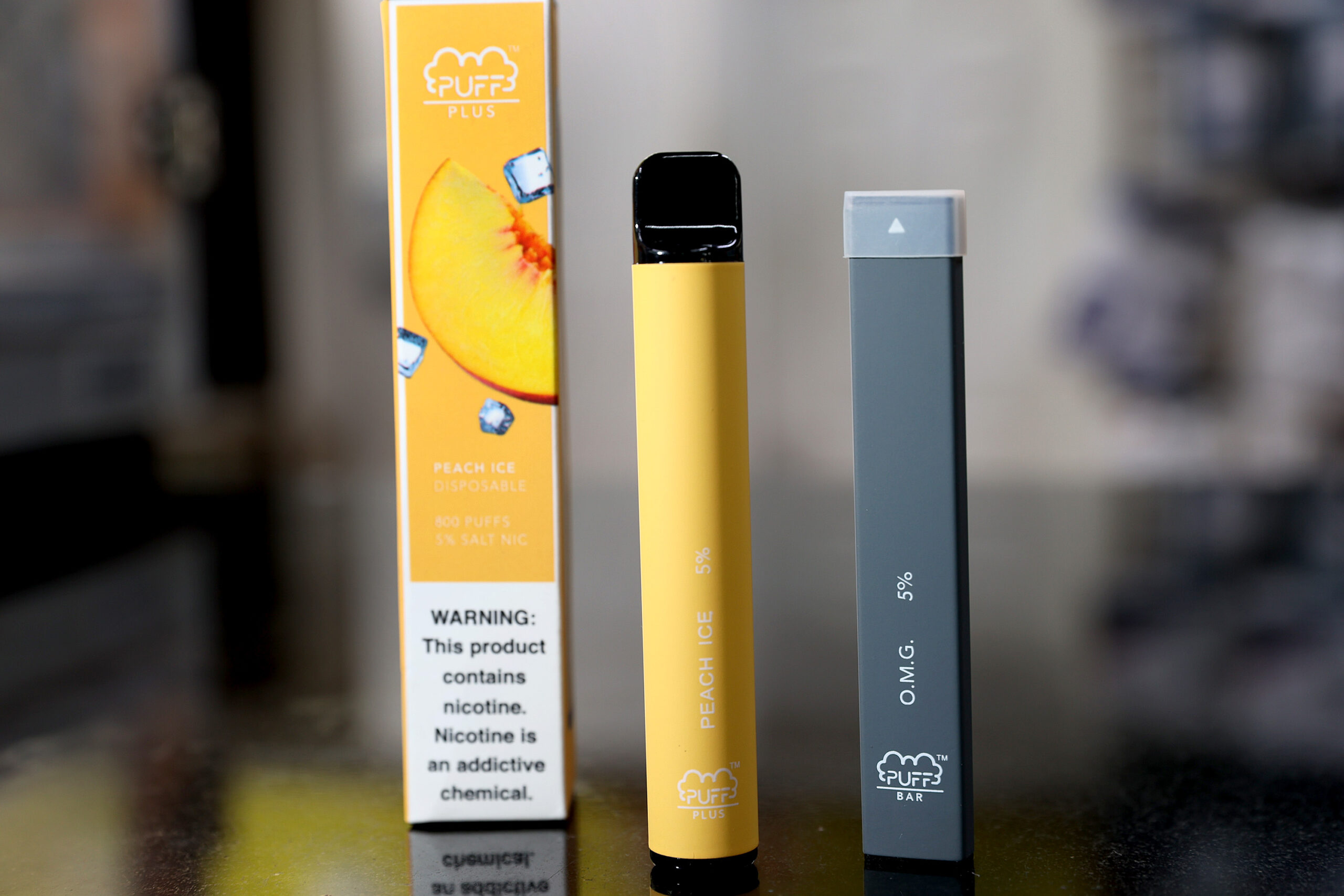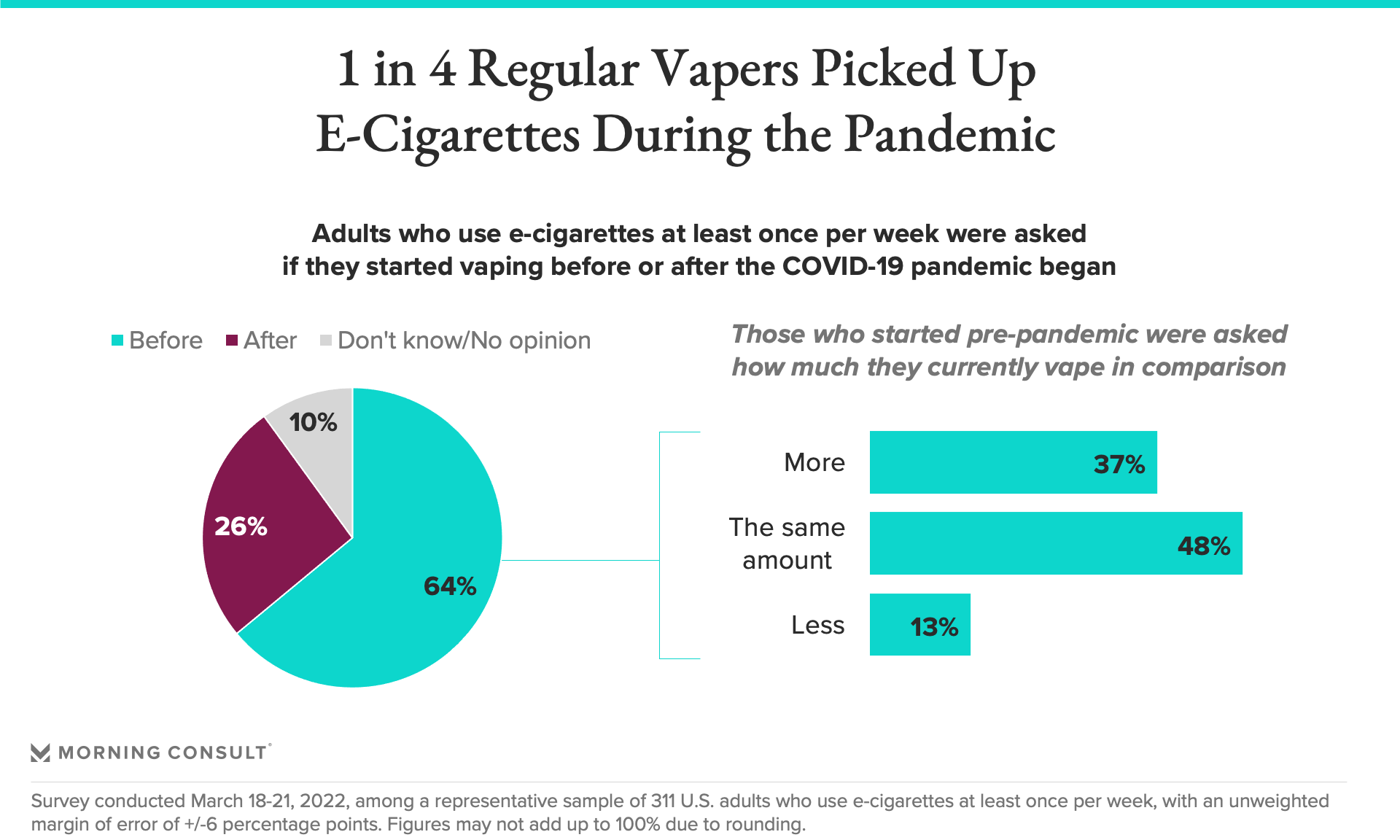Vaping Rates Have Fallen. But a Quarter of E-Cigarette Users Started During the Pandemic

Key Takeaways
About half of U.S. adults say vapes and cigarettes are equally harmful to people’s health.
Most people who vape regularly have been doing so since before the pandemic, nearly 2 in 5 saying they now use e-cigarettes more often than they did beforehand.
Adults are largely in favor of federal and state crackdowns on vape manufacturers.
A quarter of adults who vape regularly picked up the habit during the pandemic, and many are smoking too, according to a new Morning Consult survey that comes as health regulators prepare to rein in e-cigarette manufacturers amid a surge in sales but a dip in tobacco use and vaping rates.
Policymakers have been playing cat-and-mouse with e-cigarette manufacturers for years. In 2020, following public outcry over a surge in youth vaping — and an outbreak of mysterious lung illnesses that were ultimately tied to vaping THC — the Food and Drug Administration stepped up its enforcement on vape makers. This month, meanwhile, Congress plugged a loophole in those rules that allowed some manufacturers to evade FDA regulation by using synthetic nicotine rather than nicotine derived from tobacco.
E-cigarette sales have exploded over the past four years, even as U.S. vaping rates jumped and then more recently began to trend downward, including among teenagers. The estimated share of high schoolers who vape, for example, fell from 27.5% in 2019 to 11.3% in 2021, when many schools were still facing disruptions from COVID-19, meaning those rates may not be directly comparable. Meanwhile, 3.7% of adults vaped in 2020, down slightly from the year before.
Public says vapes are as harmful as cigarettes, despite potential as tool to quit smoking
The new findings offer some clues on the apparent paradox, in addition to shedding light on public perceptions of vaping as an alternative to smoking traditional cigarettes. Among adults who vape regularly and started doing so before the pandemic, 37% said they use e-cigarettes more now than before the COVID-19 crisis began, and another 48% are vaping the same amount.
The survey underscores “the importance for FDA to assert its jurisdiction regulating the product, how it’s marketed and what consumers are informed,” said Matthew Myers, president of the Campaign for Tobacco-Free Kids, an anti-smoking advocacy group.
Further, while the vaping industry says their products are smoking cessation tools — and indeed, Juul Labs Inc. has tried to clean up its image after facing a flurry of lawsuits claiming it targeted children by using fruity flavors and snappy marketing — the survey shows the public isn’t buying it.
Adults reported similar views of traditional and e-cigarettes, with roughly 7 in 10 saying they have an unfavorable view of both. Meanwhile, the public was most likely to say vapes and cigarettes are equally harmful to people’s health, at 52%, with another 16% saying e-cigarettes are worse and 14% saying traditional cigarettes are worse.
Perhaps unsurprisingly, people who use e-cigarettes regularly (at least once per week) were more likely to say vapes aren’t as bad for one’s health as traditional cigarettes.
“E-cigarettes have some promise as a smoking alternative, but they aren't some incredibly powerful magic bullet,” said Eric Lindblom, a former official at the FDA's Center for Tobacco Products who is now a senior scholar at the Georgetown University Law Center’s O’Neill Institute for National and Global Health Law.
Public Most Likely to Say Cigarettes, Vapes Are Equally Harmful
For many, vaping and smoking go hand in hand
A third of regular vapers said they also use tobacco cigarettes more than five times daily, while 40% used e-cigarettes that frequently. Just 10% of regular smokers, meanwhile, said they vape at least five times per day.
Regular smokers also had a stronger preference for cigarettes over vapes (66%) than regular vapers had for e-cigarettes over traditional cigarettes (41%).
For smokers trying to quit, e-cigarettes are meant as a complete substitute. But some people become users of both vapes and cigarettes, and research shows they may struggle to eventually wean themselves from e-cigarettes that contain nicotine.
“We're all concerned about the failure of the government to institute proper regulation, and then properly communicate about risks,” Myers said.
The broader public maintains a sour view of teens’ relationship with vaping. Nearly 3 in 4 adults are concerned about claims that vape manufacturers target their products to young people, and 72% said the companies are responsible for youth vaping — on par with the 74% who said the parents of schoolchildren are to blame.
3 in 4 Adults Blame Parents for Teen Vaping
Adults cast the blame widely, though, with another 66% saying the FDA is at fault.
“Blaming parents is sad. The manufacturers in the industry, the retailers who sell to kids, they really deserve a massive lion's share of blame for this problem,” Lindblom said. The FDA, meanwhile, “didn't cause the problem; they just didn't stop it fast and firmly,” an issue he said was due to bureaucratic and political hurdles during the Obama and Trump administrations.
More fights likely ahead between vaping industry, public health advocates
E-cigarette manufacturers will soon see if a jury agrees. After settling multimillion-dollar lawsuits in Arizona and North Carolina, Juul will face trial this summer on claims that it deliberately marketed its products to children. The company launched a massive public relations blitz when such accusations first emerged, pulling most flavors — except for menthol, which the FDA is now considering banning — from shelves in late 2018.
Not all vape makers are eager to play by the rules, though, and experts have warned that they’re likely to find other regulatory workarounds. In July 2020, for example, the FDA told Puff Bar to take its flavored vaping products off the market — but the company resumed sales in February 2021, this time using synthetic nicotine, and quickly became the No. 1 vape brand among young people.
That phenomenon prompted Congress’ recent decision to bring synthetic nicotine under FDA’s purview. And the survey shows the public is on board with tighter regulation: Two in 3 adults said the FDA should advance its efforts to limit the production of flavored e-cigarette products. Support for state-level legal action also enjoys majority support.
“E-cigarette manufacturers, for over a decade, have done everything they can to delay regulation and evade regulation,” Myers said. “It’s critically important that FDA be vigilant in enforcing the law and acting quickly when they see e-cigarette manufacturers find new ways to appeal to kids.”
Juul, Puff Bar and the FDA did not respond to requests for comment.
Gaby Galvin previously worked at Morning Consult as a reporter covering health.
